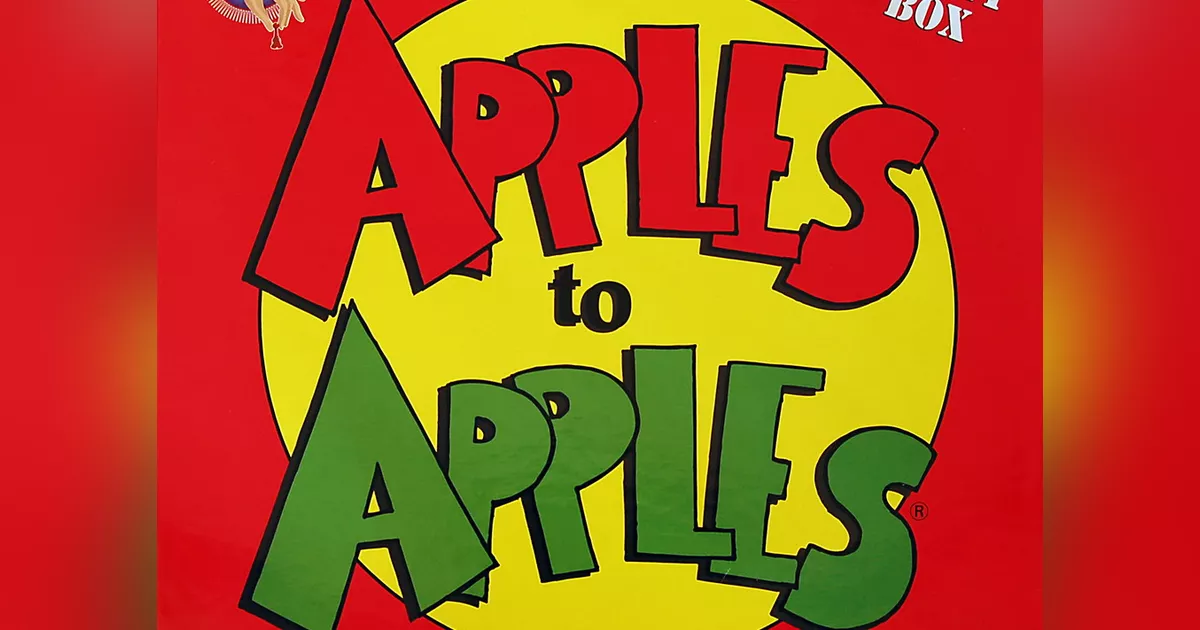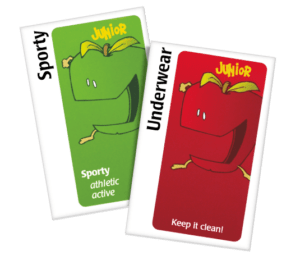Apples to Apples is a party game originally published by Out of the Box Publishing Inc., and now owned by Mattel. Designed for 4 to 10 players and intended for ages 12+, Apples to Apples is a judging board game consisting of two decks of cards: things (red cards) and adjectives (green cards). For each round, players are given a hand of seven red cards with the exception of one designated judge who draws one adjective card. A player wins the round by playing the red card that the judge determines is the best match for the green card. The player that wins the round becomes the judge in the subsequent round. Pictured below is an example of a green “adjective” card and a red “thing” card.
Central Argument
Judging is a core mechanic to Apples to Apples, as the designated judge must choose the red “thing” card that they believe suits the green “adjective” card the best. Therefore, many may think that Apples to Apples involves only one judge at all times. However, I argue that all players at all times must take on the role of “judge” in order to succeed. Due to the omnipresence of judging in Apples to Apples, the game brings forth social interaction and empathy in its group dynamics.
Analysis
Judging is omnipresent in Apples to Apples, as it is a role that all players must take on at all times throughout the game. For any given turn, each player must judge which of their red cards fits the green card best. Once the judge reveals which red card best matches the green card, discussion and mayhem ensue. At least when I played Apples to Apples, we had the judge list off the red cards from last to first place. As the judge read off each card that didn’t win, the players who dealt those cards would defend their pick and lobby for why they believed it was a good match. Therefore, judging led to the dynamic of players defending their card choices. Furthermore, once the judge finally read the red card that won, players playfully accused the winning card of being undeserving. As a result, social interaction is naturally interwoven into the gameplay. Pictured below is a group’s reaction after the judge chooses the winning card – we see the winning player celebrating while the losing players appear unsatisfied and in playful argument with the judge.
On a more meta level, judging is also present in how players must judge which of their red cards is most strategic to put down. For example, imagine the green card was “Hairy” but a player’s only options to choose from were elephants, giant squid, and Dr. Kevorkian. Since none of the options obviously suit the adjective, “hairy,” it may be in the player’s best interest to simply treat this round as a “throwaway round” and put down the card they deem the most disposable. Considering this, one suggestion I have for the game is to include “wild cards” that allow players to have the card be whatever they want. This would help lessen instances in which players have no decent options to choose from.
Finally, because Apples to Apples relies heavily on subjectivity as a byproduct of its judging-centered mechanics, it’s not enough for players to simply be their own judge when deciding which of their cards they think best fits the green card; players must put themselves in the shoes of the designated judge when making their selections. For example, if a player knows that the designated judge is an abstract thinker, then if the green adjective card was “heavy,” the player might choose to place down “taxes” over a more straightforward choice such as “elephants.” Comparatively, if we look at another judging game such as skribble.io, we see that there’s only one correct answer that yields a point for each round. Due to the “one correct answer” mechanic found in skribbl.io, putting oneself in the shoes of others is not as central to the game’s dynamics as it is in Apples to Apples. Therefore, we see that empathy is a natural dynamic that results from the mechanic of there being one designated judge and the innate subjectivity that it entails. Within the magic circle of the game, relationships are naturally strengthened through trying to understand how others’ minds operate. Pictured below is a visual representation of two players trying to put themselves in the shoes of the other – essentially trying to think like how the other would think.

Overall, the subjectivity found in the judging mechanics in Apples to Apples creates the dynamics of social interaction and empathy, leading to the fostering of fellowship. The open-endedness of Apples of Apples proved to be an incredibly effective design decision by the game creators.





